IP Networks and Multimedia Services: A Comprehensive Overview
VerifiedAdded on 2023/02/01
|9
|3752
|81
Report
AI Summary
This report provides a comprehensive overview of IP networks and multimedia services, with a specific focus on Voice over Internet Protocol (VoIP). It begins with an introduction to IP networks and their role in facilitating various multimedia services like IPTV and video streaming. The report then delves into the specifics of VoIP, including its history, different service categories (such as IP Phones and Analog Telephone Adaptors), advantages, and disadvantages. A detailed analysis of VoIP's architecture is presented, outlining key components like SIP servers, service brokers, application servers, and media servers. The report also covers IP protocol layering and explores various VoIP protocols, including H.248, H.323, RTP, and SIP. Furthermore, it examines the devices used in VoIP technology, such as IP desk phones and softphones, and discusses their applications in both business and daily life. The report concludes with a discussion on the future of VoIP, providing a well-structured and informative analysis of this important technology.
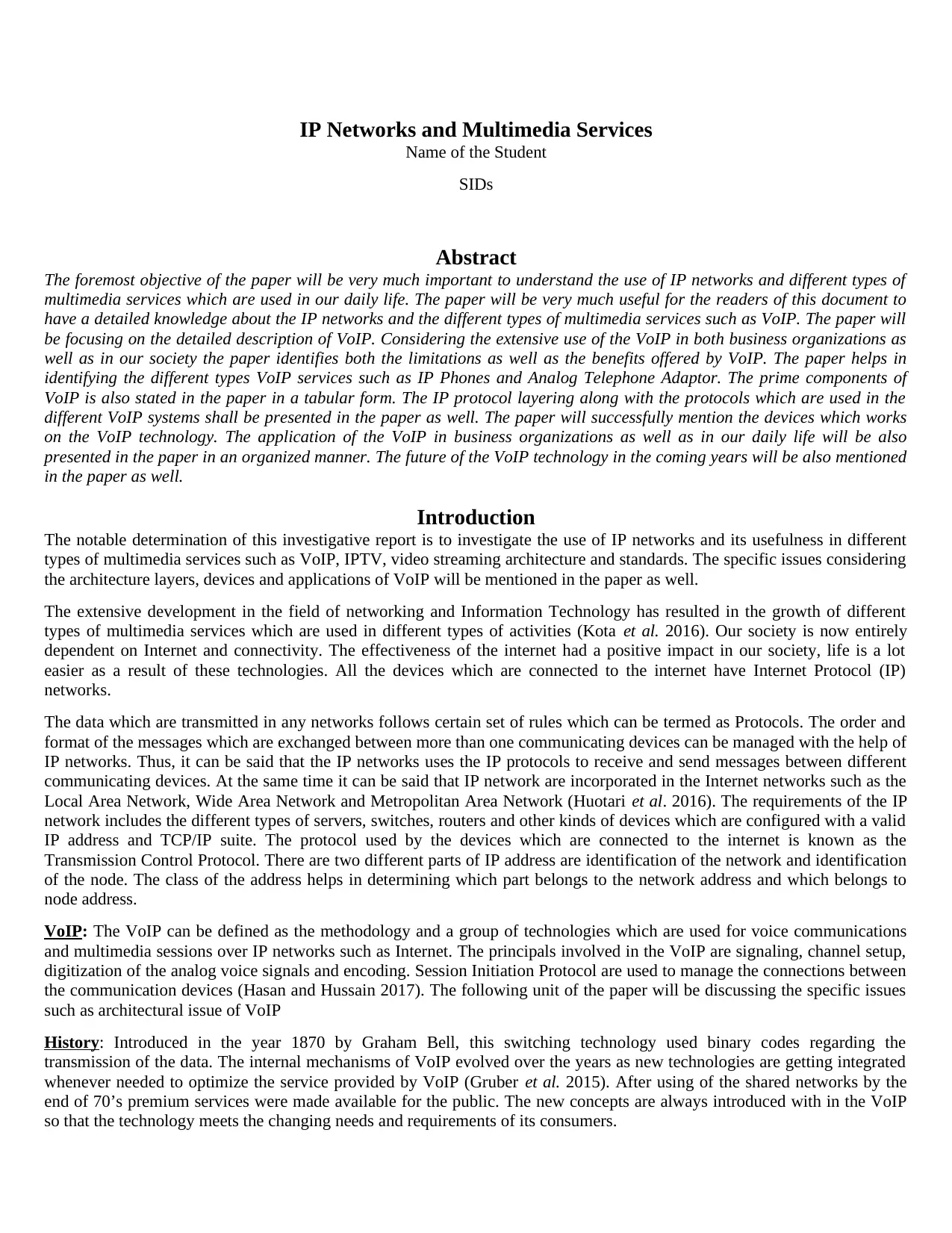
IP Networks and Multimedia Services
Name of the Student
SIDs
Abstract
The foremost objective of the paper will be very much important to understand the use of IP networks and different types of
multimedia services which are used in our daily life. The paper will be very much useful for the readers of this document to
have a detailed knowledge about the IP networks and the different types of multimedia services such as VoIP. The paper will
be focusing on the detailed description of VoIP. Considering the extensive use of the VoIP in both business organizations as
well as in our society the paper identifies both the limitations as well as the benefits offered by VoIP. The paper helps in
identifying the different types VoIP services such as IP Phones and Analog Telephone Adaptor. The prime components of
VoIP is also stated in the paper in a tabular form. The IP protocol layering along with the protocols which are used in the
different VoIP systems shall be presented in the paper as well. The paper will successfully mention the devices which works
on the VoIP technology. The application of the VoIP in business organizations as well as in our daily life will be also
presented in the paper in an organized manner. The future of the VoIP technology in the coming years will be also mentioned
in the paper as well.
Introduction
The notable determination of this investigative report is to investigate the use of IP networks and its usefulness in different
types of multimedia services such as VoIP, IPTV, video streaming architecture and standards. The specific issues considering
the architecture layers, devices and applications of VoIP will be mentioned in the paper as well.
The extensive development in the field of networking and Information Technology has resulted in the growth of different
types of multimedia services which are used in different types of activities (Kota et al. 2016). Our society is now entirely
dependent on Internet and connectivity. The effectiveness of the internet had a positive impact in our society, life is a lot
easier as a result of these technologies. All the devices which are connected to the internet have Internet Protocol (IP)
networks.
The data which are transmitted in any networks follows certain set of rules which can be termed as Protocols. The order and
format of the messages which are exchanged between more than one communicating devices can be managed with the help of
IP networks. Thus, it can be said that the IP networks uses the IP protocols to receive and send messages between different
communicating devices. At the same time it can be said that IP network are incorporated in the Internet networks such as the
Local Area Network, Wide Area Network and Metropolitan Area Network (Huotari et al. 2016). The requirements of the IP
network includes the different types of servers, switches, routers and other kinds of devices which are configured with a valid
IP address and TCP/IP suite. The protocol used by the devices which are connected to the internet is known as the
Transmission Control Protocol. There are two different parts of IP address are identification of the network and identification
of the node. The class of the address helps in determining which part belongs to the network address and which belongs to
node address.
VoIP: The VoIP can be defined as the methodology and a group of technologies which are used for voice communications
and multimedia sessions over IP networks such as Internet. The principals involved in the VoIP are signaling, channel setup,
digitization of the analog voice signals and encoding. Session Initiation Protocol are used to manage the connections between
the communication devices (Hasan and Hussain 2017). The following unit of the paper will be discussing the specific issues
such as architectural issue of VoIP
History: Introduced in the year 1870 by Graham Bell, this switching technology used binary codes regarding the
transmission of the data. The internal mechanisms of VoIP evolved over the years as new technologies are getting integrated
whenever needed to optimize the service provided by VoIP (Gruber et al. 2015). After using of the shared networks by the
end of 70’s premium services were made available for the public. The new concepts are always introduced with in the VoIP
so that the technology meets the changing needs and requirements of its consumers.
Name of the Student
SIDs
Abstract
The foremost objective of the paper will be very much important to understand the use of IP networks and different types of
multimedia services which are used in our daily life. The paper will be very much useful for the readers of this document to
have a detailed knowledge about the IP networks and the different types of multimedia services such as VoIP. The paper will
be focusing on the detailed description of VoIP. Considering the extensive use of the VoIP in both business organizations as
well as in our society the paper identifies both the limitations as well as the benefits offered by VoIP. The paper helps in
identifying the different types VoIP services such as IP Phones and Analog Telephone Adaptor. The prime components of
VoIP is also stated in the paper in a tabular form. The IP protocol layering along with the protocols which are used in the
different VoIP systems shall be presented in the paper as well. The paper will successfully mention the devices which works
on the VoIP technology. The application of the VoIP in business organizations as well as in our daily life will be also
presented in the paper in an organized manner. The future of the VoIP technology in the coming years will be also mentioned
in the paper as well.
Introduction
The notable determination of this investigative report is to investigate the use of IP networks and its usefulness in different
types of multimedia services such as VoIP, IPTV, video streaming architecture and standards. The specific issues considering
the architecture layers, devices and applications of VoIP will be mentioned in the paper as well.
The extensive development in the field of networking and Information Technology has resulted in the growth of different
types of multimedia services which are used in different types of activities (Kota et al. 2016). Our society is now entirely
dependent on Internet and connectivity. The effectiveness of the internet had a positive impact in our society, life is a lot
easier as a result of these technologies. All the devices which are connected to the internet have Internet Protocol (IP)
networks.
The data which are transmitted in any networks follows certain set of rules which can be termed as Protocols. The order and
format of the messages which are exchanged between more than one communicating devices can be managed with the help of
IP networks. Thus, it can be said that the IP networks uses the IP protocols to receive and send messages between different
communicating devices. At the same time it can be said that IP network are incorporated in the Internet networks such as the
Local Area Network, Wide Area Network and Metropolitan Area Network (Huotari et al. 2016). The requirements of the IP
network includes the different types of servers, switches, routers and other kinds of devices which are configured with a valid
IP address and TCP/IP suite. The protocol used by the devices which are connected to the internet is known as the
Transmission Control Protocol. There are two different parts of IP address are identification of the network and identification
of the node. The class of the address helps in determining which part belongs to the network address and which belongs to
node address.
VoIP: The VoIP can be defined as the methodology and a group of technologies which are used for voice communications
and multimedia sessions over IP networks such as Internet. The principals involved in the VoIP are signaling, channel setup,
digitization of the analog voice signals and encoding. Session Initiation Protocol are used to manage the connections between
the communication devices (Hasan and Hussain 2017). The following unit of the paper will be discussing the specific issues
such as architectural issue of VoIP
History: Introduced in the year 1870 by Graham Bell, this switching technology used binary codes regarding the
transmission of the data. The internal mechanisms of VoIP evolved over the years as new technologies are getting integrated
whenever needed to optimize the service provided by VoIP (Gruber et al. 2015). After using of the shared networks by the
end of 70’s premium services were made available for the public. The new concepts are always introduced with in the VoIP
so that the technology meets the changing needs and requirements of its consumers.
Paraphrase This Document
Need a fresh take? Get an instant paraphrase of this document with our AI Paraphraser
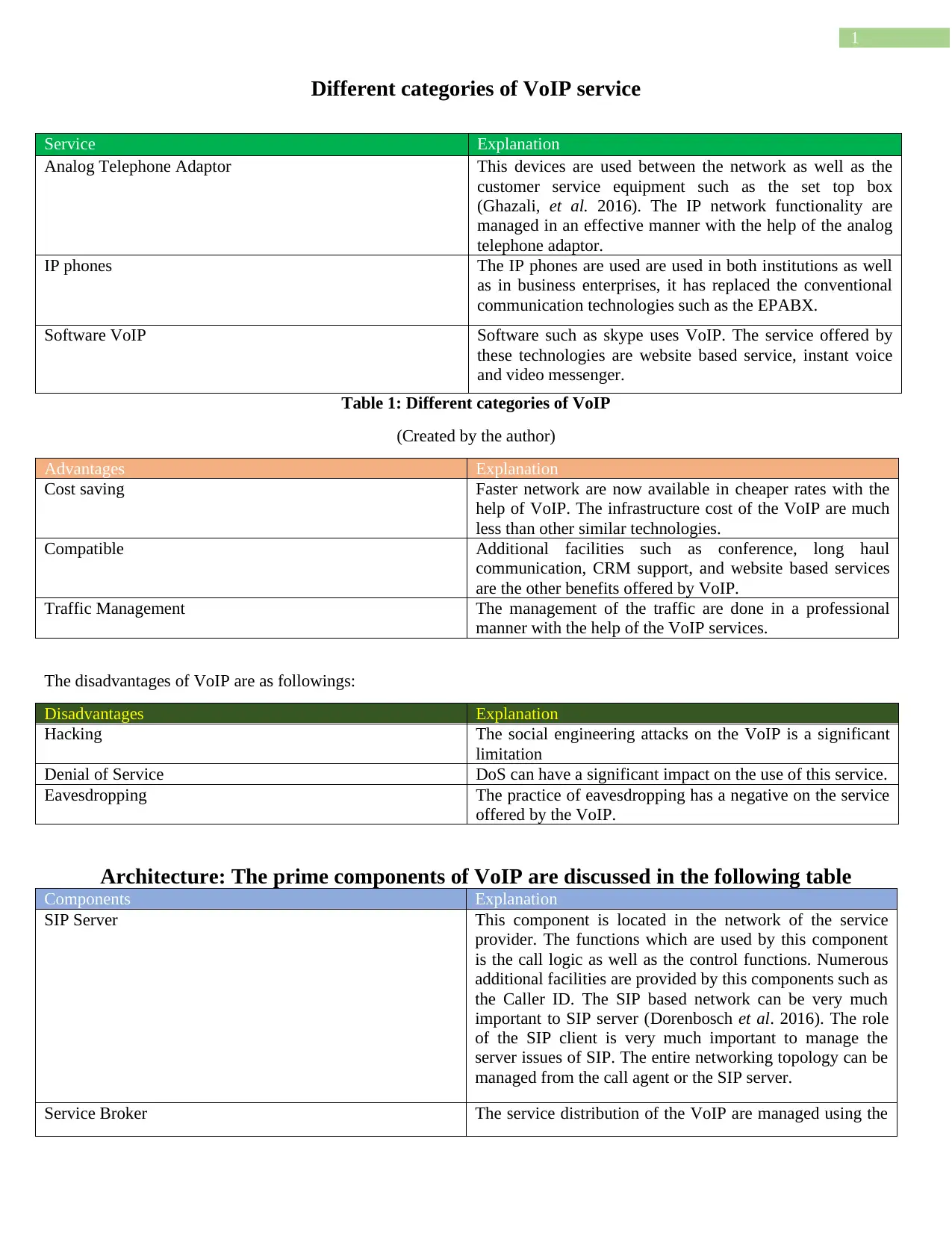
1
Different categories of VoIP service
Service Explanation
Analog Telephone Adaptor This devices are used between the network as well as the
customer service equipment such as the set top box
(Ghazali, et al. 2016). The IP network functionality are
managed in an effective manner with the help of the analog
telephone adaptor.
IP phones The IP phones are used are used in both institutions as well
as in business enterprises, it has replaced the conventional
communication technologies such as the EPABX.
Software VoIP Software such as skype uses VoIP. The service offered by
these technologies are website based service, instant voice
and video messenger.
Table 1: Different categories of VoIP
(Created by the author)
Advantages Explanation
Cost saving Faster network are now available in cheaper rates with the
help of VoIP. The infrastructure cost of the VoIP are much
less than other similar technologies.
Compatible Additional facilities such as conference, long haul
communication, CRM support, and website based services
are the other benefits offered by VoIP.
Traffic Management The management of the traffic are done in a professional
manner with the help of the VoIP services.
The disadvantages of VoIP are as followings:
Disadvantages Explanation
Hacking The social engineering attacks on the VoIP is a significant
limitation
Denial of Service DoS can have a significant impact on the use of this service.
Eavesdropping The practice of eavesdropping has a negative on the service
offered by the VoIP.
Architecture: The prime components of VoIP are discussed in the following table
Components Explanation
SIP Server This component is located in the network of the service
provider. The functions which are used by this component
is the call logic as well as the control functions. Numerous
additional facilities are provided by this components such as
the Caller ID. The SIP based network can be very much
important to SIP server (Dorenbosch et al. 2016). The role
of the SIP client is very much important to manage the
server issues of SIP. The entire networking topology can be
managed from the call agent or the SIP server.
Service Broker The service distribution of the VoIP are managed using the
Different categories of VoIP service
Service Explanation
Analog Telephone Adaptor This devices are used between the network as well as the
customer service equipment such as the set top box
(Ghazali, et al. 2016). The IP network functionality are
managed in an effective manner with the help of the analog
telephone adaptor.
IP phones The IP phones are used are used in both institutions as well
as in business enterprises, it has replaced the conventional
communication technologies such as the EPABX.
Software VoIP Software such as skype uses VoIP. The service offered by
these technologies are website based service, instant voice
and video messenger.
Table 1: Different categories of VoIP
(Created by the author)
Advantages Explanation
Cost saving Faster network are now available in cheaper rates with the
help of VoIP. The infrastructure cost of the VoIP are much
less than other similar technologies.
Compatible Additional facilities such as conference, long haul
communication, CRM support, and website based services
are the other benefits offered by VoIP.
Traffic Management The management of the traffic are done in a professional
manner with the help of the VoIP services.
The disadvantages of VoIP are as followings:
Disadvantages Explanation
Hacking The social engineering attacks on the VoIP is a significant
limitation
Denial of Service DoS can have a significant impact on the use of this service.
Eavesdropping The practice of eavesdropping has a negative on the service
offered by the VoIP.
Architecture: The prime components of VoIP are discussed in the following table
Components Explanation
SIP Server This component is located in the network of the service
provider. The functions which are used by this component
is the call logic as well as the control functions. Numerous
additional facilities are provided by this components such as
the Caller ID. The SIP based network can be very much
important to SIP server (Dorenbosch et al. 2016). The role
of the SIP client is very much important to manage the
server issues of SIP. The entire networking topology can be
managed from the call agent or the SIP server.
Service Broker The service distribution of the VoIP are managed using the
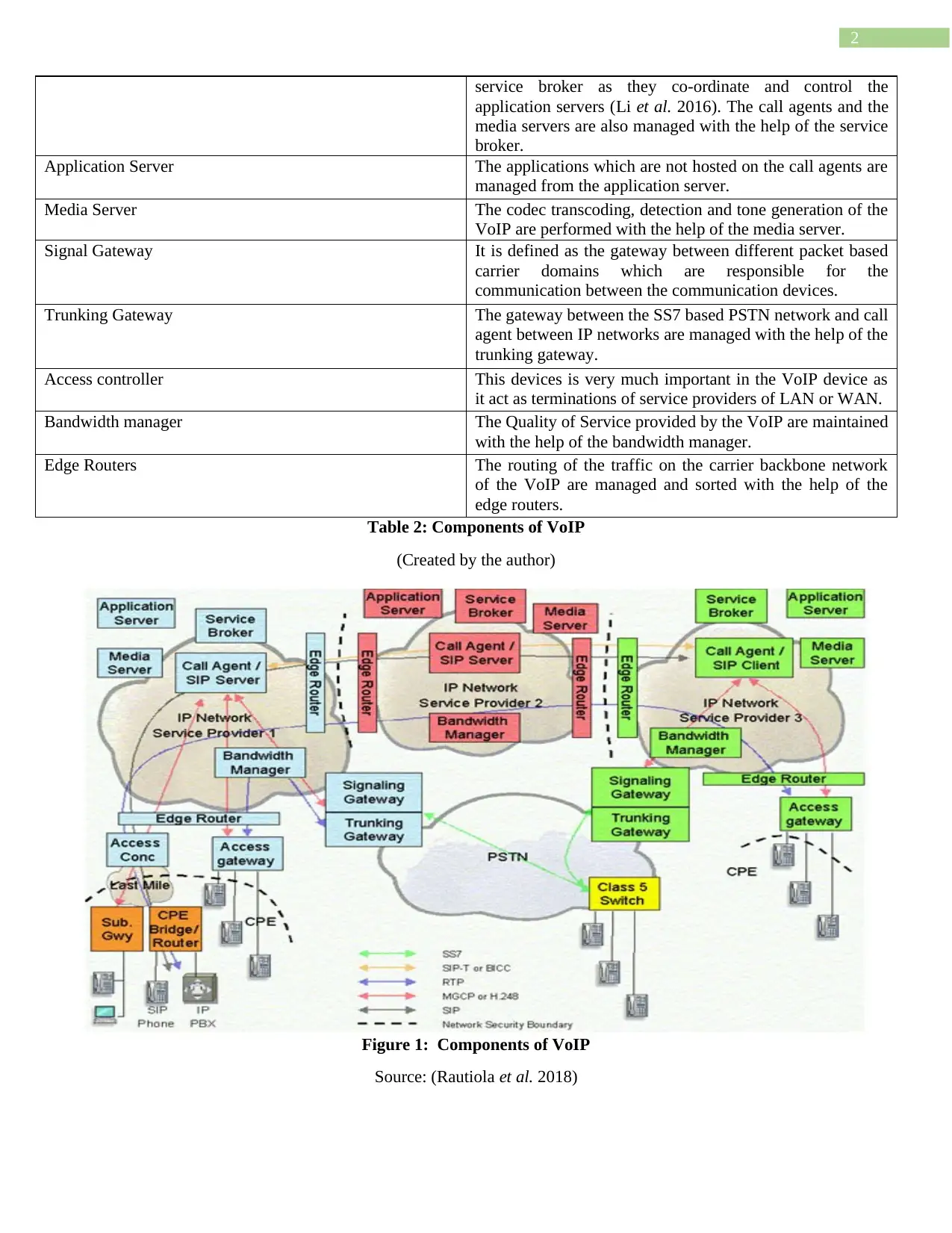
2
service broker as they co-ordinate and control the
application servers (Li et al. 2016). The call agents and the
media servers are also managed with the help of the service
broker.
Application Server The applications which are not hosted on the call agents are
managed from the application server.
Media Server The codec transcoding, detection and tone generation of the
VoIP are performed with the help of the media server.
Signal Gateway It is defined as the gateway between different packet based
carrier domains which are responsible for the
communication between the communication devices.
Trunking Gateway The gateway between the SS7 based PSTN network and call
agent between IP networks are managed with the help of the
trunking gateway.
Access controller This devices is very much important in the VoIP device as
it act as terminations of service providers of LAN or WAN.
Bandwidth manager The Quality of Service provided by the VoIP are maintained
with the help of the bandwidth manager.
Edge Routers The routing of the traffic on the carrier backbone network
of the VoIP are managed and sorted with the help of the
edge routers.
Table 2: Components of VoIP
(Created by the author)
Figure 1: Components of VoIP
Source: (Rautiola et al. 2018)
service broker as they co-ordinate and control the
application servers (Li et al. 2016). The call agents and the
media servers are also managed with the help of the service
broker.
Application Server The applications which are not hosted on the call agents are
managed from the application server.
Media Server The codec transcoding, detection and tone generation of the
VoIP are performed with the help of the media server.
Signal Gateway It is defined as the gateway between different packet based
carrier domains which are responsible for the
communication between the communication devices.
Trunking Gateway The gateway between the SS7 based PSTN network and call
agent between IP networks are managed with the help of the
trunking gateway.
Access controller This devices is very much important in the VoIP device as
it act as terminations of service providers of LAN or WAN.
Bandwidth manager The Quality of Service provided by the VoIP are maintained
with the help of the bandwidth manager.
Edge Routers The routing of the traffic on the carrier backbone network
of the VoIP are managed and sorted with the help of the
edge routers.
Table 2: Components of VoIP
(Created by the author)
Figure 1: Components of VoIP
Source: (Rautiola et al. 2018)
⊘ This is a preview!⊘
Do you want full access?
Subscribe today to unlock all pages.

Trusted by 1+ million students worldwide
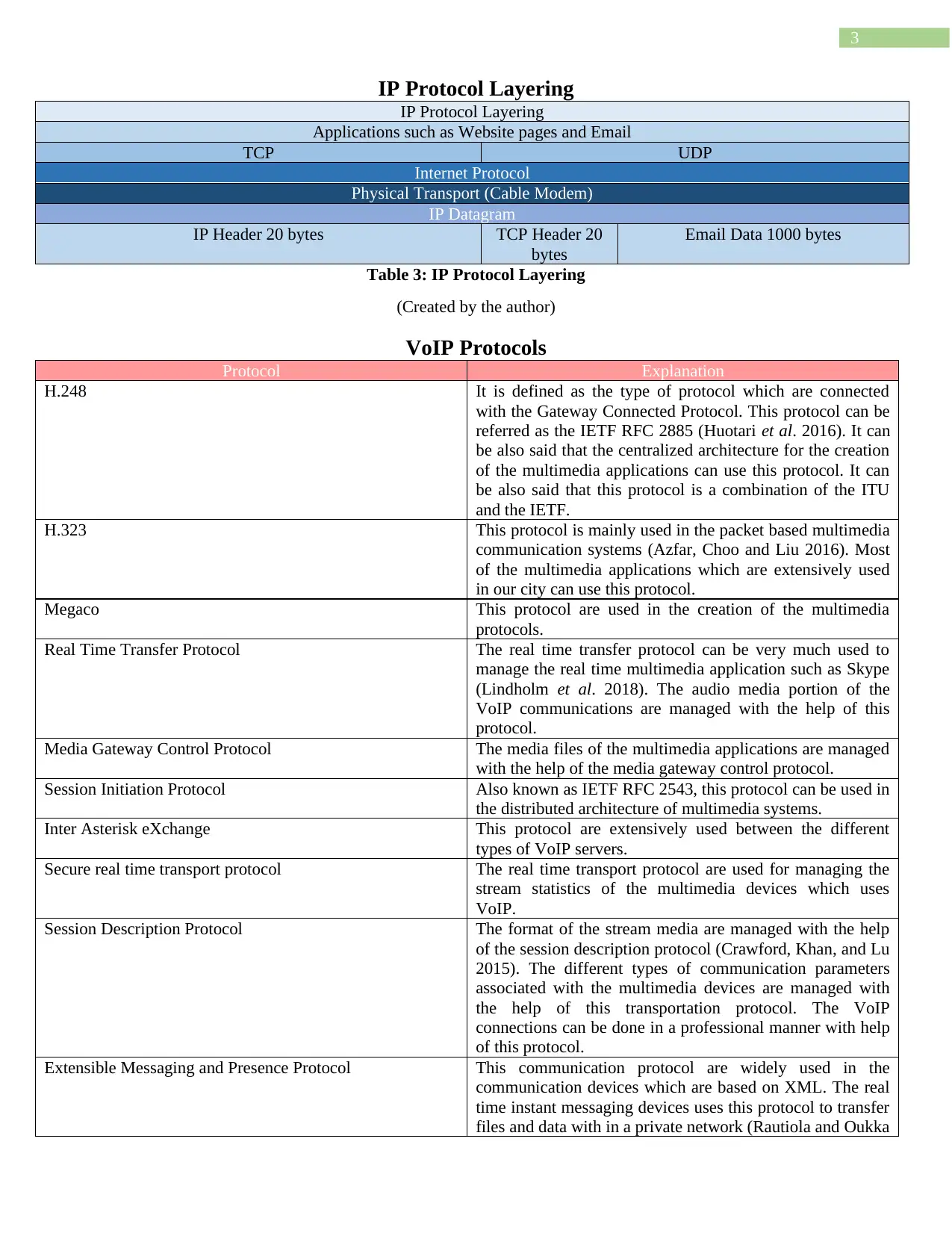
3
IP Protocol Layering
IP Protocol Layering
Applications such as Website pages and Email
TCP UDP
Internet Protocol
Physical Transport (Cable Modem)
IP Datagram
IP Header 20 bytes TCP Header 20
bytes
Email Data 1000 bytes
Table 3: IP Protocol Layering
(Created by the author)
VoIP Protocols
Protocol Explanation
H.248 It is defined as the type of protocol which are connected
with the Gateway Connected Protocol. This protocol can be
referred as the IETF RFC 2885 (Huotari et al. 2016). It can
be also said that the centralized architecture for the creation
of the multimedia applications can use this protocol. It can
be also said that this protocol is a combination of the ITU
and the IETF.
H.323 This protocol is mainly used in the packet based multimedia
communication systems (Azfar, Choo and Liu 2016). Most
of the multimedia applications which are extensively used
in our city can use this protocol.
Megaco This protocol are used in the creation of the multimedia
protocols.
Real Time Transfer Protocol The real time transfer protocol can be very much used to
manage the real time multimedia application such as Skype
(Lindholm et al. 2018). The audio media portion of the
VoIP communications are managed with the help of this
protocol.
Media Gateway Control Protocol The media files of the multimedia applications are managed
with the help of the media gateway control protocol.
Session Initiation Protocol Also known as IETF RFC 2543, this protocol can be used in
the distributed architecture of multimedia systems.
Inter Asterisk eXchange This protocol are extensively used between the different
types of VoIP servers.
Secure real time transport protocol The real time transport protocol are used for managing the
stream statistics of the multimedia devices which uses
VoIP.
Session Description Protocol The format of the stream media are managed with the help
of the session description protocol (Crawford, Khan, and Lu
2015). The different types of communication parameters
associated with the multimedia devices are managed with
the help of this transportation protocol. The VoIP
connections can be done in a professional manner with help
of this protocol.
Extensible Messaging and Presence Protocol This communication protocol are widely used in the
communication devices which are based on XML. The real
time instant messaging devices uses this protocol to transfer
files and data with in a private network (Rautiola and Oukka
IP Protocol Layering
IP Protocol Layering
Applications such as Website pages and Email
TCP UDP
Internet Protocol
Physical Transport (Cable Modem)
IP Datagram
IP Header 20 bytes TCP Header 20
bytes
Email Data 1000 bytes
Table 3: IP Protocol Layering
(Created by the author)
VoIP Protocols
Protocol Explanation
H.248 It is defined as the type of protocol which are connected
with the Gateway Connected Protocol. This protocol can be
referred as the IETF RFC 2885 (Huotari et al. 2016). It can
be also said that the centralized architecture for the creation
of the multimedia applications can use this protocol. It can
be also said that this protocol is a combination of the ITU
and the IETF.
H.323 This protocol is mainly used in the packet based multimedia
communication systems (Azfar, Choo and Liu 2016). Most
of the multimedia applications which are extensively used
in our city can use this protocol.
Megaco This protocol are used in the creation of the multimedia
protocols.
Real Time Transfer Protocol The real time transfer protocol can be very much used to
manage the real time multimedia application such as Skype
(Lindholm et al. 2018). The audio media portion of the
VoIP communications are managed with the help of this
protocol.
Media Gateway Control Protocol The media files of the multimedia applications are managed
with the help of the media gateway control protocol.
Session Initiation Protocol Also known as IETF RFC 2543, this protocol can be used in
the distributed architecture of multimedia systems.
Inter Asterisk eXchange This protocol are extensively used between the different
types of VoIP servers.
Secure real time transport protocol The real time transport protocol are used for managing the
stream statistics of the multimedia devices which uses
VoIP.
Session Description Protocol The format of the stream media are managed with the help
of the session description protocol (Crawford, Khan, and Lu
2015). The different types of communication parameters
associated with the multimedia devices are managed with
the help of this transportation protocol. The VoIP
connections can be done in a professional manner with help
of this protocol.
Extensible Messaging and Presence Protocol This communication protocol are widely used in the
communication devices which are based on XML. The real
time instant messaging devices uses this protocol to transfer
files and data with in a private network (Rautiola and Oukka
Paraphrase This Document
Need a fresh take? Get an instant paraphrase of this document with our AI Paraphraser
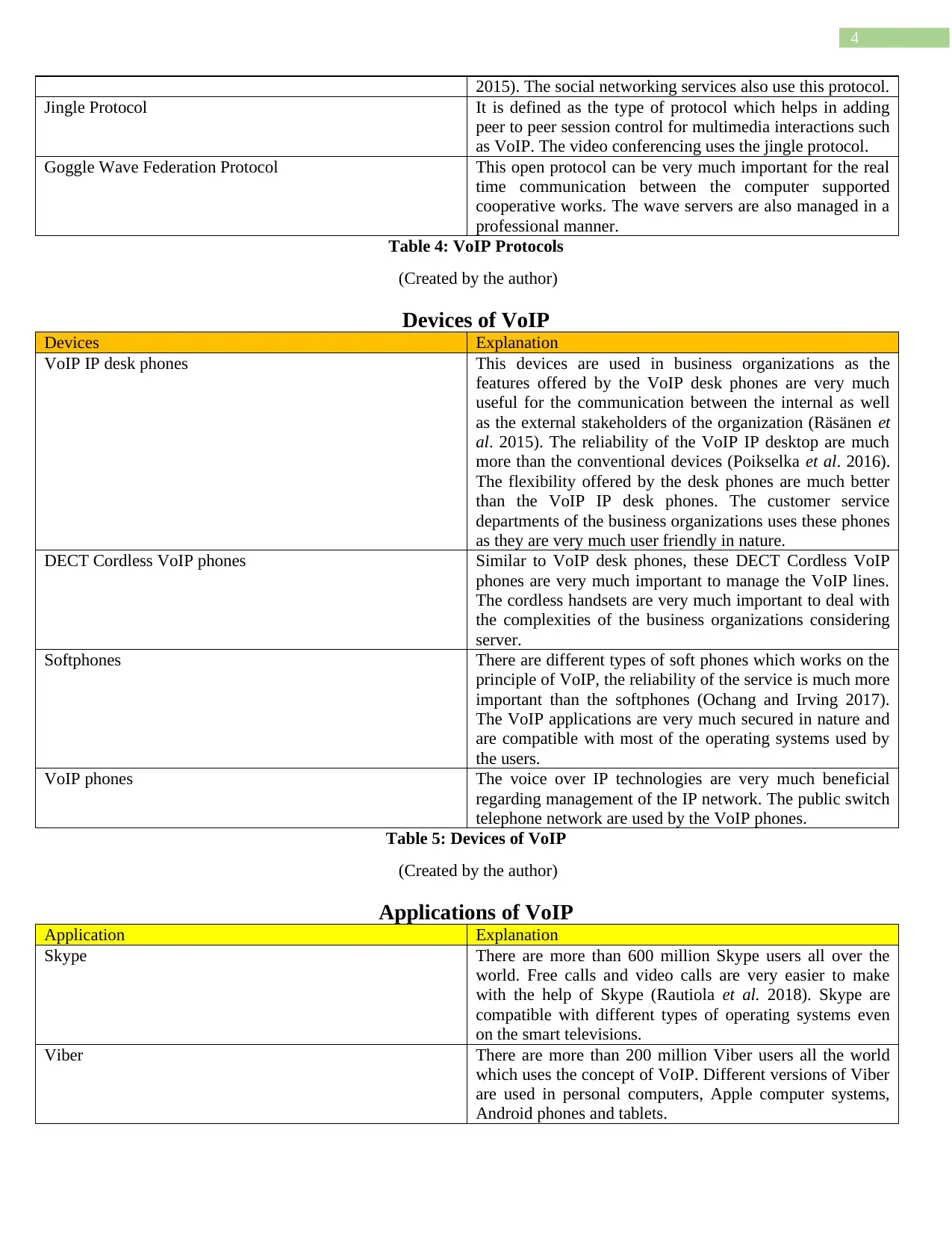
4
2015). The social networking services also use this protocol.
Jingle Protocol It is defined as the type of protocol which helps in adding
peer to peer session control for multimedia interactions such
as VoIP. The video conferencing uses the jingle protocol.
Goggle Wave Federation Protocol This open protocol can be very much important for the real
time communication between the computer supported
cooperative works. The wave servers are also managed in a
professional manner.
Table 4: VoIP Protocols
(Created by the author)
Devices of VoIP
Devices Explanation
VoIP IP desk phones This devices are used in business organizations as the
features offered by the VoIP desk phones are very much
useful for the communication between the internal as well
as the external stakeholders of the organization (Räsänen et
al. 2015). The reliability of the VoIP IP desktop are much
more than the conventional devices (Poikselka et al. 2016).
The flexibility offered by the desk phones are much better
than the VoIP IP desk phones. The customer service
departments of the business organizations uses these phones
as they are very much user friendly in nature.
DECT Cordless VoIP phones Similar to VoIP desk phones, these DECT Cordless VoIP
phones are very much important to manage the VoIP lines.
The cordless handsets are very much important to deal with
the complexities of the business organizations considering
server.
Softphones There are different types of soft phones which works on the
principle of VoIP, the reliability of the service is much more
important than the softphones (Ochang and Irving 2017).
The VoIP applications are very much secured in nature and
are compatible with most of the operating systems used by
the users.
VoIP phones The voice over IP technologies are very much beneficial
regarding management of the IP network. The public switch
telephone network are used by the VoIP phones.
Table 5: Devices of VoIP
(Created by the author)
Applications of VoIP
Application Explanation
Skype There are more than 600 million Skype users all over the
world. Free calls and video calls are very easier to make
with the help of Skype (Rautiola et al. 2018). Skype are
compatible with different types of operating systems even
on the smart televisions.
Viber There are more than 200 million Viber users all the world
which uses the concept of VoIP. Different versions of Viber
are used in personal computers, Apple computer systems,
Android phones and tablets.
2015). The social networking services also use this protocol.
Jingle Protocol It is defined as the type of protocol which helps in adding
peer to peer session control for multimedia interactions such
as VoIP. The video conferencing uses the jingle protocol.
Goggle Wave Federation Protocol This open protocol can be very much important for the real
time communication between the computer supported
cooperative works. The wave servers are also managed in a
professional manner.
Table 4: VoIP Protocols
(Created by the author)
Devices of VoIP
Devices Explanation
VoIP IP desk phones This devices are used in business organizations as the
features offered by the VoIP desk phones are very much
useful for the communication between the internal as well
as the external stakeholders of the organization (Räsänen et
al. 2015). The reliability of the VoIP IP desktop are much
more than the conventional devices (Poikselka et al. 2016).
The flexibility offered by the desk phones are much better
than the VoIP IP desk phones. The customer service
departments of the business organizations uses these phones
as they are very much user friendly in nature.
DECT Cordless VoIP phones Similar to VoIP desk phones, these DECT Cordless VoIP
phones are very much important to manage the VoIP lines.
The cordless handsets are very much important to deal with
the complexities of the business organizations considering
server.
Softphones There are different types of soft phones which works on the
principle of VoIP, the reliability of the service is much more
important than the softphones (Ochang and Irving 2017).
The VoIP applications are very much secured in nature and
are compatible with most of the operating systems used by
the users.
VoIP phones The voice over IP technologies are very much beneficial
regarding management of the IP network. The public switch
telephone network are used by the VoIP phones.
Table 5: Devices of VoIP
(Created by the author)
Applications of VoIP
Application Explanation
Skype There are more than 600 million Skype users all over the
world. Free calls and video calls are very easier to make
with the help of Skype (Rautiola et al. 2018). Skype are
compatible with different types of operating systems even
on the smart televisions.
Viber There are more than 200 million Viber users all the world
which uses the concept of VoIP. Different versions of Viber
are used in personal computers, Apple computer systems,
Android phones and tablets.
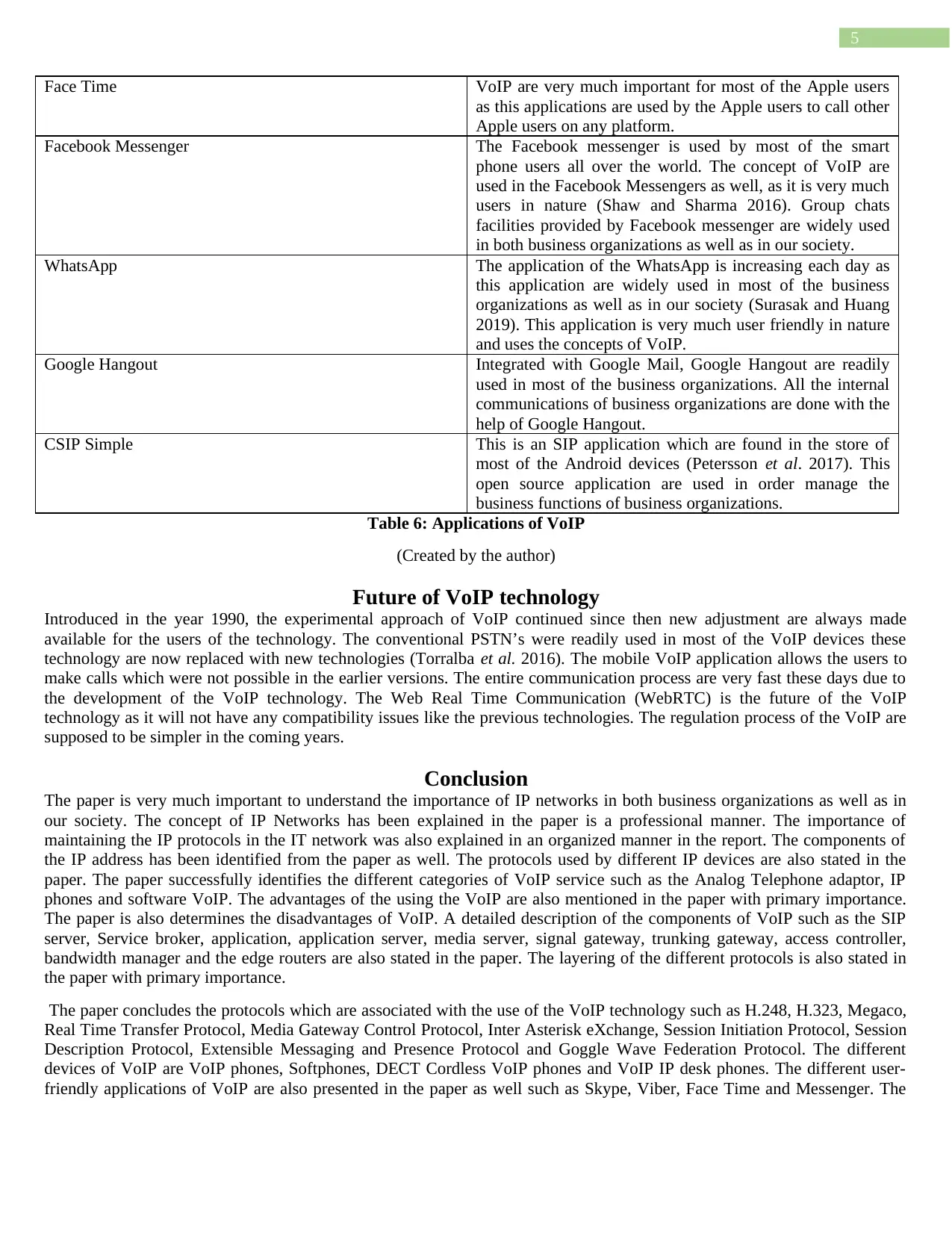
5
Face Time VoIP are very much important for most of the Apple users
as this applications are used by the Apple users to call other
Apple users on any platform.
Facebook Messenger The Facebook messenger is used by most of the smart
phone users all over the world. The concept of VoIP are
used in the Facebook Messengers as well, as it is very much
users in nature (Shaw and Sharma 2016). Group chats
facilities provided by Facebook messenger are widely used
in both business organizations as well as in our society.
WhatsApp The application of the WhatsApp is increasing each day as
this application are widely used in most of the business
organizations as well as in our society (Surasak and Huang
2019). This application is very much user friendly in nature
and uses the concepts of VoIP.
Google Hangout Integrated with Google Mail, Google Hangout are readily
used in most of the business organizations. All the internal
communications of business organizations are done with the
help of Google Hangout.
CSIP Simple This is an SIP application which are found in the store of
most of the Android devices (Petersson et al. 2017). This
open source application are used in order manage the
business functions of business organizations.
Table 6: Applications of VoIP
(Created by the author)
Future of VoIP technology
Introduced in the year 1990, the experimental approach of VoIP continued since then new adjustment are always made
available for the users of the technology. The conventional PSTN’s were readily used in most of the VoIP devices these
technology are now replaced with new technologies (Torralba et al. 2016). The mobile VoIP application allows the users to
make calls which were not possible in the earlier versions. The entire communication process are very fast these days due to
the development of the VoIP technology. The Web Real Time Communication (WebRTC) is the future of the VoIP
technology as it will not have any compatibility issues like the previous technologies. The regulation process of the VoIP are
supposed to be simpler in the coming years.
Conclusion
The paper is very much important to understand the importance of IP networks in both business organizations as well as in
our society. The concept of IP Networks has been explained in the paper is a professional manner. The importance of
maintaining the IP protocols in the IT network was also explained in an organized manner in the report. The components of
the IP address has been identified from the paper as well. The protocols used by different IP devices are also stated in the
paper. The paper successfully identifies the different categories of VoIP service such as the Analog Telephone adaptor, IP
phones and software VoIP. The advantages of the using the VoIP are also mentioned in the paper with primary importance.
The paper is also determines the disadvantages of VoIP. A detailed description of the components of VoIP such as the SIP
server, Service broker, application, application server, media server, signal gateway, trunking gateway, access controller,
bandwidth manager and the edge routers are also stated in the paper. The layering of the different protocols is also stated in
the paper with primary importance.
The paper concludes the protocols which are associated with the use of the VoIP technology such as H.248, H.323, Megaco,
Real Time Transfer Protocol, Media Gateway Control Protocol, Inter Asterisk eXchange, Session Initiation Protocol, Session
Description Protocol, Extensible Messaging and Presence Protocol and Goggle Wave Federation Protocol. The different
devices of VoIP are VoIP phones, Softphones, DECT Cordless VoIP phones and VoIP IP desk phones. The different user-
friendly applications of VoIP are also presented in the paper as well such as Skype, Viber, Face Time and Messenger. The
Face Time VoIP are very much important for most of the Apple users
as this applications are used by the Apple users to call other
Apple users on any platform.
Facebook Messenger The Facebook messenger is used by most of the smart
phone users all over the world. The concept of VoIP are
used in the Facebook Messengers as well, as it is very much
users in nature (Shaw and Sharma 2016). Group chats
facilities provided by Facebook messenger are widely used
in both business organizations as well as in our society.
WhatsApp The application of the WhatsApp is increasing each day as
this application are widely used in most of the business
organizations as well as in our society (Surasak and Huang
2019). This application is very much user friendly in nature
and uses the concepts of VoIP.
Google Hangout Integrated with Google Mail, Google Hangout are readily
used in most of the business organizations. All the internal
communications of business organizations are done with the
help of Google Hangout.
CSIP Simple This is an SIP application which are found in the store of
most of the Android devices (Petersson et al. 2017). This
open source application are used in order manage the
business functions of business organizations.
Table 6: Applications of VoIP
(Created by the author)
Future of VoIP technology
Introduced in the year 1990, the experimental approach of VoIP continued since then new adjustment are always made
available for the users of the technology. The conventional PSTN’s were readily used in most of the VoIP devices these
technology are now replaced with new technologies (Torralba et al. 2016). The mobile VoIP application allows the users to
make calls which were not possible in the earlier versions. The entire communication process are very fast these days due to
the development of the VoIP technology. The Web Real Time Communication (WebRTC) is the future of the VoIP
technology as it will not have any compatibility issues like the previous technologies. The regulation process of the VoIP are
supposed to be simpler in the coming years.
Conclusion
The paper is very much important to understand the importance of IP networks in both business organizations as well as in
our society. The concept of IP Networks has been explained in the paper is a professional manner. The importance of
maintaining the IP protocols in the IT network was also explained in an organized manner in the report. The components of
the IP address has been identified from the paper as well. The protocols used by different IP devices are also stated in the
paper. The paper successfully identifies the different categories of VoIP service such as the Analog Telephone adaptor, IP
phones and software VoIP. The advantages of the using the VoIP are also mentioned in the paper with primary importance.
The paper is also determines the disadvantages of VoIP. A detailed description of the components of VoIP such as the SIP
server, Service broker, application, application server, media server, signal gateway, trunking gateway, access controller,
bandwidth manager and the edge routers are also stated in the paper. The layering of the different protocols is also stated in
the paper with primary importance.
The paper concludes the protocols which are associated with the use of the VoIP technology such as H.248, H.323, Megaco,
Real Time Transfer Protocol, Media Gateway Control Protocol, Inter Asterisk eXchange, Session Initiation Protocol, Session
Description Protocol, Extensible Messaging and Presence Protocol and Goggle Wave Federation Protocol. The different
devices of VoIP are VoIP phones, Softphones, DECT Cordless VoIP phones and VoIP IP desk phones. The different user-
friendly applications of VoIP are also presented in the paper as well such as Skype, Viber, Face Time and Messenger. The
⊘ This is a preview!⊘
Do you want full access?
Subscribe today to unlock all pages.

Trusted by 1+ million students worldwide

6
future implication of the VoIP was also presented in the paper as well. Thus, this investigative report helps in understanding
the specific issues of the architecture, layers, and protocols devices and application of VoIP.
future implication of the VoIP was also presented in the paper as well. Thus, this investigative report helps in understanding
the specific issues of the architecture, layers, and protocols devices and application of VoIP.
Paraphrase This Document
Need a fresh take? Get an instant paraphrase of this document with our AI Paraphraser
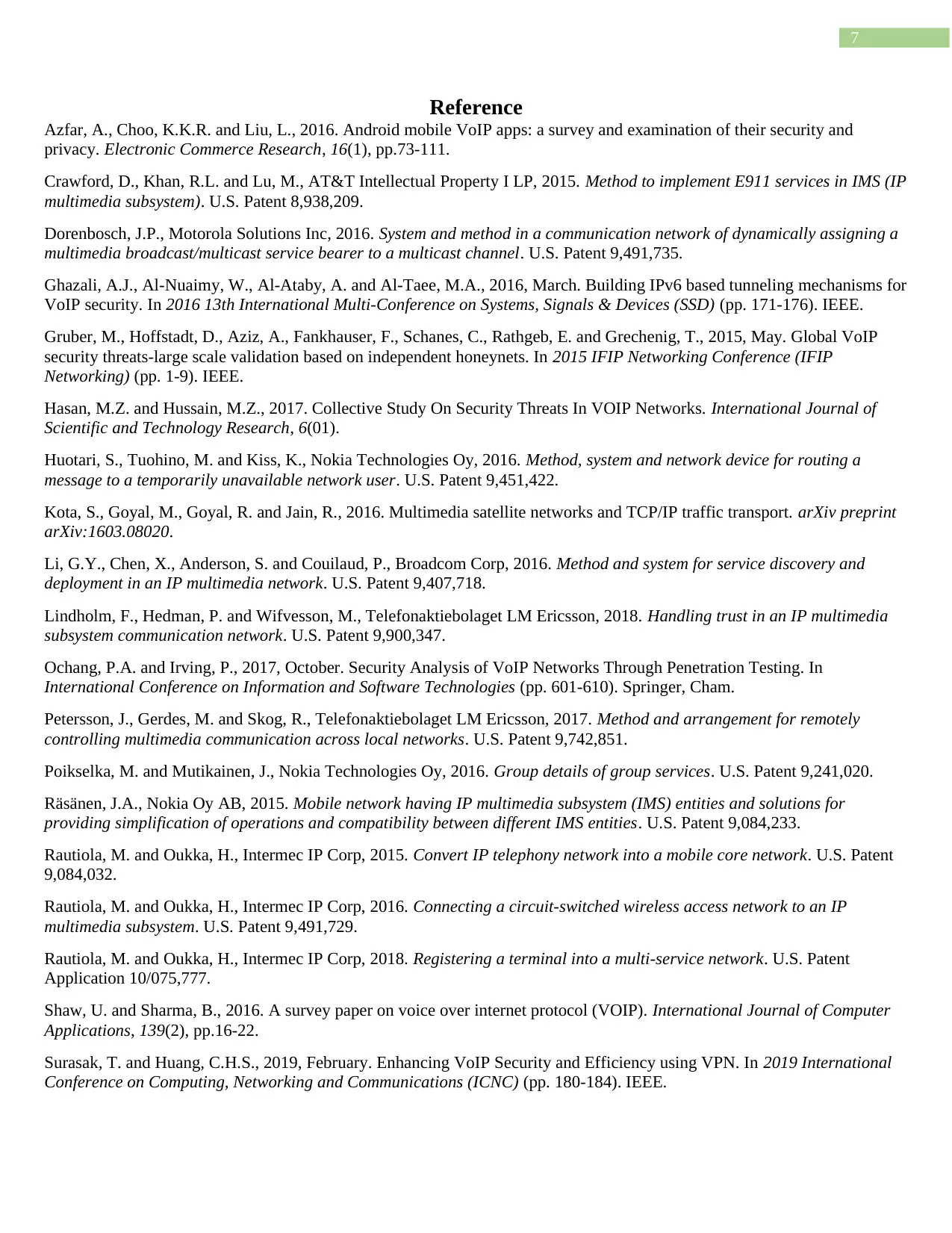
7
Reference
Azfar, A., Choo, K.K.R. and Liu, L., 2016. Android mobile VoIP apps: a survey and examination of their security and
privacy. Electronic Commerce Research, 16(1), pp.73-111.
Crawford, D., Khan, R.L. and Lu, M., AT&T Intellectual Property I LP, 2015. Method to implement E911 services in IMS (IP
multimedia subsystem). U.S. Patent 8,938,209.
Dorenbosch, J.P., Motorola Solutions Inc, 2016. System and method in a communication network of dynamically assigning a
multimedia broadcast/multicast service bearer to a multicast channel. U.S. Patent 9,491,735.
Ghazali, A.J., Al-Nuaimy, W., Al-Ataby, A. and Al-Taee, M.A., 2016, March. Building IPv6 based tunneling mechanisms for
VoIP security. In 2016 13th International Multi-Conference on Systems, Signals & Devices (SSD) (pp. 171-176). IEEE.
Gruber, M., Hoffstadt, D., Aziz, A., Fankhauser, F., Schanes, C., Rathgeb, E. and Grechenig, T., 2015, May. Global VoIP
security threats-large scale validation based on independent honeynets. In 2015 IFIP Networking Conference (IFIP
Networking) (pp. 1-9). IEEE.
Hasan, M.Z. and Hussain, M.Z., 2017. Collective Study On Security Threats In VOIP Networks. International Journal of
Scientific and Technology Research, 6(01).
Huotari, S., Tuohino, M. and Kiss, K., Nokia Technologies Oy, 2016. Method, system and network device for routing a
message to a temporarily unavailable network user. U.S. Patent 9,451,422.
Kota, S., Goyal, M., Goyal, R. and Jain, R., 2016. Multimedia satellite networks and TCP/IP traffic transport. arXiv preprint
arXiv:1603.08020.
Li, G.Y., Chen, X., Anderson, S. and Couilaud, P., Broadcom Corp, 2016. Method and system for service discovery and
deployment in an IP multimedia network. U.S. Patent 9,407,718.
Lindholm, F., Hedman, P. and Wifvesson, M., Telefonaktiebolaget LM Ericsson, 2018. Handling trust in an IP multimedia
subsystem communication network. U.S. Patent 9,900,347.
Ochang, P.A. and Irving, P., 2017, October. Security Analysis of VoIP Networks Through Penetration Testing. In
International Conference on Information and Software Technologies (pp. 601-610). Springer, Cham.
Petersson, J., Gerdes, M. and Skog, R., Telefonaktiebolaget LM Ericsson, 2017. Method and arrangement for remotely
controlling multimedia communication across local networks. U.S. Patent 9,742,851.
Poikselka, M. and Mutikainen, J., Nokia Technologies Oy, 2016. Group details of group services. U.S. Patent 9,241,020.
Räsänen, J.A., Nokia Oy AB, 2015. Mobile network having IP multimedia subsystem (IMS) entities and solutions for
providing simplification of operations and compatibility between different IMS entities. U.S. Patent 9,084,233.
Rautiola, M. and Oukka, H., Intermec IP Corp, 2015. Convert IP telephony network into a mobile core network. U.S. Patent
9,084,032.
Rautiola, M. and Oukka, H., Intermec IP Corp, 2016. Connecting a circuit-switched wireless access network to an IP
multimedia subsystem. U.S. Patent 9,491,729.
Rautiola, M. and Oukka, H., Intermec IP Corp, 2018. Registering a terminal into a multi-service network. U.S. Patent
Application 10/075,777.
Shaw, U. and Sharma, B., 2016. A survey paper on voice over internet protocol (VOIP). International Journal of Computer
Applications, 139(2), pp.16-22.
Surasak, T. and Huang, C.H.S., 2019, February. Enhancing VoIP Security and Efficiency using VPN. In 2019 International
Conference on Computing, Networking and Communications (ICNC) (pp. 180-184). IEEE.
Reference
Azfar, A., Choo, K.K.R. and Liu, L., 2016. Android mobile VoIP apps: a survey and examination of their security and
privacy. Electronic Commerce Research, 16(1), pp.73-111.
Crawford, D., Khan, R.L. and Lu, M., AT&T Intellectual Property I LP, 2015. Method to implement E911 services in IMS (IP
multimedia subsystem). U.S. Patent 8,938,209.
Dorenbosch, J.P., Motorola Solutions Inc, 2016. System and method in a communication network of dynamically assigning a
multimedia broadcast/multicast service bearer to a multicast channel. U.S. Patent 9,491,735.
Ghazali, A.J., Al-Nuaimy, W., Al-Ataby, A. and Al-Taee, M.A., 2016, March. Building IPv6 based tunneling mechanisms for
VoIP security. In 2016 13th International Multi-Conference on Systems, Signals & Devices (SSD) (pp. 171-176). IEEE.
Gruber, M., Hoffstadt, D., Aziz, A., Fankhauser, F., Schanes, C., Rathgeb, E. and Grechenig, T., 2015, May. Global VoIP
security threats-large scale validation based on independent honeynets. In 2015 IFIP Networking Conference (IFIP
Networking) (pp. 1-9). IEEE.
Hasan, M.Z. and Hussain, M.Z., 2017. Collective Study On Security Threats In VOIP Networks. International Journal of
Scientific and Technology Research, 6(01).
Huotari, S., Tuohino, M. and Kiss, K., Nokia Technologies Oy, 2016. Method, system and network device for routing a
message to a temporarily unavailable network user. U.S. Patent 9,451,422.
Kota, S., Goyal, M., Goyal, R. and Jain, R., 2016. Multimedia satellite networks and TCP/IP traffic transport. arXiv preprint
arXiv:1603.08020.
Li, G.Y., Chen, X., Anderson, S. and Couilaud, P., Broadcom Corp, 2016. Method and system for service discovery and
deployment in an IP multimedia network. U.S. Patent 9,407,718.
Lindholm, F., Hedman, P. and Wifvesson, M., Telefonaktiebolaget LM Ericsson, 2018. Handling trust in an IP multimedia
subsystem communication network. U.S. Patent 9,900,347.
Ochang, P.A. and Irving, P., 2017, October. Security Analysis of VoIP Networks Through Penetration Testing. In
International Conference on Information and Software Technologies (pp. 601-610). Springer, Cham.
Petersson, J., Gerdes, M. and Skog, R., Telefonaktiebolaget LM Ericsson, 2017. Method and arrangement for remotely
controlling multimedia communication across local networks. U.S. Patent 9,742,851.
Poikselka, M. and Mutikainen, J., Nokia Technologies Oy, 2016. Group details of group services. U.S. Patent 9,241,020.
Räsänen, J.A., Nokia Oy AB, 2015. Mobile network having IP multimedia subsystem (IMS) entities and solutions for
providing simplification of operations and compatibility between different IMS entities. U.S. Patent 9,084,233.
Rautiola, M. and Oukka, H., Intermec IP Corp, 2015. Convert IP telephony network into a mobile core network. U.S. Patent
9,084,032.
Rautiola, M. and Oukka, H., Intermec IP Corp, 2016. Connecting a circuit-switched wireless access network to an IP
multimedia subsystem. U.S. Patent 9,491,729.
Rautiola, M. and Oukka, H., Intermec IP Corp, 2018. Registering a terminal into a multi-service network. U.S. Patent
Application 10/075,777.
Shaw, U. and Sharma, B., 2016. A survey paper on voice over internet protocol (VOIP). International Journal of Computer
Applications, 139(2), pp.16-22.
Surasak, T. and Huang, C.H.S., 2019, February. Enhancing VoIP Security and Efficiency using VPN. In 2019 International
Conference on Computing, Networking and Communications (ICNC) (pp. 180-184). IEEE.

8
Torralba, F.C., Johansson, T., Österlund, H. and Díaz-Chirón, M.E.T., Telefonaktiebolaget LM Ericsson AB, 2016. Methods
and apparatuses for initiating provisioning of subscriber data in a HSS of an IP multimedia subsystem network. U.S. Patent
9,479,600.
Torralba, F.C., Johansson, T., Österlund, H. and Díaz-Chirón, M.E.T., Telefonaktiebolaget LM Ericsson AB, 2016. Methods
and apparatuses for initiating provisioning of subscriber data in a HSS of an IP multimedia subsystem network. U.S. Patent
9,479,600.
⊘ This is a preview!⊘
Do you want full access?
Subscribe today to unlock all pages.

Trusted by 1+ million students worldwide
1 out of 9
Related Documents
Your All-in-One AI-Powered Toolkit for Academic Success.
+13062052269
info@desklib.com
Available 24*7 on WhatsApp / Email
![[object Object]](/_next/static/media/star-bottom.7253800d.svg)
Unlock your academic potential
Copyright © 2020–2025 A2Z Services. All Rights Reserved. Developed and managed by ZUCOL.





